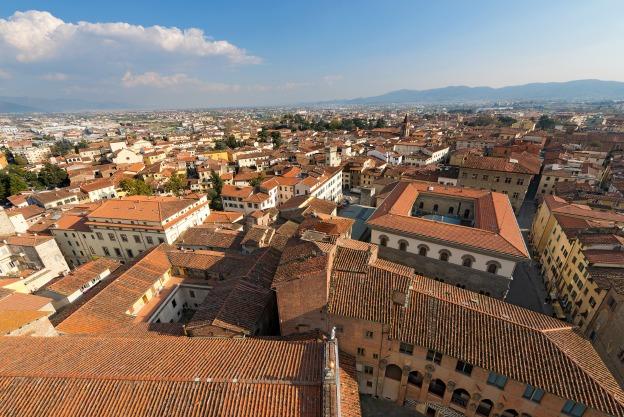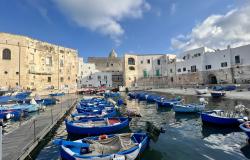[View of Pistoia, Italy's Capital of Culture for 2017.]
As you plan your ITALY travels for 2017, here’s the scoop on what’s new around the boot. Of course the list below doesn’t presume to be exhaustive – just keep following us, we’ll keep you updated on all the latest news concerning the best of Italy travel, culture, food and lifestyle!
Rome
The Braccio Nuovo (New Wing) in the Museo Chiaramonti of the Vatican Museums reopened to the public just one week before the end of 2016, after a seven-year-long restoration . The gallery is a jewel of neoclassical architecture, built between 1816 and 1822 for Pope Pius VII by the Roman architect Raffaele Stern under the supervision of sculptor extraordinaire Antonio Canova. The restoration has brought to light the original colors of the gallery, eliminating the dusty blanket that gave the space a uniform grey-beige color; the 28 marble statues portraying emperors and Roman replicas of famous Greek statues (featuring such important statues as The Prima Porta Augustus, Doryphorus, and The River Nile) have regained their original whiteness; the floor, made of large marble slabs framing original Roman mosaics, has been carefully polished. Access to the New Wing is included with the entrance to the Vatican Museums.

Incidentally, the Vatican has hired its first female museum director, art historian Barbara Jatta, who took up her new post on January 1.
Speaking of women making an impact, don’t forget to visit the exhibition dedicated to the greatest female artist of the Baroque age, Artemisia Gentileschi, on view at Museum of Rome in Palazzo Braschi, near Piazza Navona, until May 7, 2017.
A visit to the Ara Pacis, a masterpiece altar built between 13 and 9 BC to celebrate the peace achieved by emperor Augustus over the territories of the empire, has turned into a virtual journey, thanks to an immersive tour and multimedia narration, which allows visitors to experience the monument as it originally was, including its once bright colors, and to see how it changed over time, including the area where it once stood, and how it was eventually buried under subsequent constructions during the Middle Ages. Sounds, voices, colors and stories make you feel as if you’ve stepped into ancient Rome. The 45-minute tour will be open to the public from 8 pm to midnight on Friday and Saturday until April 15 and every evening from April 21 until October 31.
Florence
Giorgio Vasari’s Last Supper is back on display in the Basilica of Santa Croce for the first time since the flood that hit Florence in 1966, when the panel painting remained submerged in water for 12 hours. It took Florence’s renowned Opificio delle Pietre Dure ten years to restore the badly damaged 6,60-meter-long and 2,62-meter-high painting, which can now be raised quickly in the event of a flood thanks to a system of counterweights. Vasari, the author of The Lives of the Artist, was commissioned the painting in 1546 for the Cloistered Nuns of the Murate. The clean-up has brought to light the painting’s extraordinary vivid colors.

Good news for those visiting Florence in the winter low season (besides the fewer crowds): by purchasing online the ticket for the Grande Museo del Duomo, which includes entrance to Giotto’s Campanile, San Giovanni’s Baptistry, the Cathedrals of Santa Maria del Fiore and Santa Reparata, and the new Museo dell'Opera del Duomo, you will pay a discounted rate of €10 (instead of €15). The offer is valid until March 21, 2017 and can be bought here.
Milan
You can now admire, in all its magnificence, the effect of perspective created by Donato Bramante at the end of the 15th century in the Basilica of Santa Maria presso San Satiro thanks to a new lighting system using LED technology. Bramante's work on the basilica is a brilliant example of the use of perspective: asked to create an apse for the basilica, but unable to extend the length of the building due to the street behind, he created a false apse through the use of painted perspective, realizing one of the first examples of trompe l'oeil in the history of art (the apse is indeed less than a meter deep). The Basilica of Santa Maria presso San Satiro is only a few steps from Piazza del Duomo and worth a peek inside.
The Prada Foundation has launched a new photography gallery in a spectacular location, the fifth and sixth floors of Milan’s oldest shopping arcade, the Galleria Vittorio Emanuele II, which opened in 1877. With huge windows overlooking the roofing of the gallery, the new exhibition space, called Osservatorio, constitutes a vantage point over Milan’s ‘living room’, the Galleria where Mario Prada, the grandfather of Miuccia Prada, the current co-CEO and lead designer of the fashion empire, opened the brand’s first store in 1913. According to the foundation’s website, the Osservatorio is “a place where trends and expressions in contemporary photography are explored, investigating the constant evolution of this medium and its connections with other disciplines and creative realms.”

Bologna
What better place than Bologna, Italy’s foodie capital, to open a theme park dedicated to the best of Italian food? The 80,000-square-meter space, called FICO Eataly World, is scheduled to open in October, and will include 40 ‘fabbriche’, shops showcasing Italy’s extraordinary regional biodiversity through some of its best artisanal products, from pasta to mozzarella, from cured meats to cheeses, to olive oil and much more. FICO will house four acres of pastures and fields growing essential regional crops, such as olives, grape varietals and truffles, and will be a great place to learn about Italian food – how it is made, how to best savor it, how to be sustainable in its production.
Pompeii
The House of the Vettii, one of the richest in Pompeii, famous for its erotic frescoes, has reopened after 12 years. It is now possible to visit the entrance area, the atrium with its surrounding niches and triclinium with its stunning series of mythological frescoes. The most richly decorated rooms however remain closed, although a restoration project has been promised.
New ‘Bandiera Arancione’ Villages on the Map
The Bandiera Arancione (Orange Flag in Italian) is a recognition of quality awarded by the Touring Club Italiano to small towns (population 15,000 or less) in Italy for excellency in tourism, hospitality and the environment. At the end of 2016, seven new ‘orange flags’ were assigned, and for anyone who loves borghi, add the following to your must-see list:
Opi (L’Aquila, Abruzzo)
Serra San Quirico (Ancona, Le Marche)
Almenno San Bartolomeo (Bergamo, Lombardia)
Gavi (Alessandria, Piemonte)
Agliè (Torino, Piemonte)
Oriolo (Cosenza, Calabria)
Taverna (Catanzaro, Calabria)
Pistoia

Pistoia, 30 km from Florence, is Italy’s Capital of Culture for 2017. This little-known Tuscan town plans to invest more than 15 million euros to revamp urban areas and cultural infrastructure. It is the perfect chance to get to know this medieval town and its impressive sights, such as Piazza del Duomo and its 67-meter-high campanile, and the 13th-century Ospedale del Ceppo, founded as a hospital in medieval times and renovated in the Renaissance by the Medici family, and set to be transformed into a multi-use cultural center.
Happy ITALY planning!
To stay up-to-date on all things Italy, make sure to sign up to our free weekly newsletter and follow us on our social media channels.





